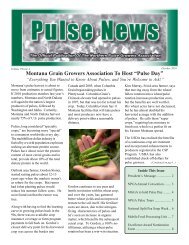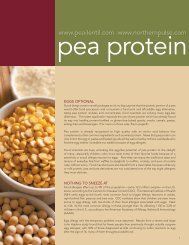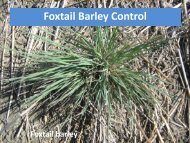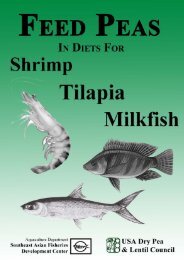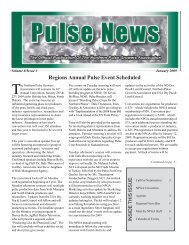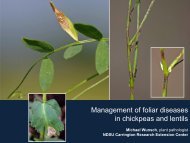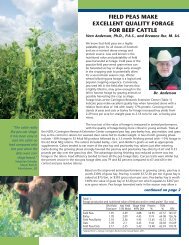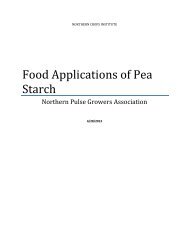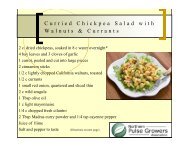Processed feed pea and canola meal for blue shrimp diets
Processed feed pea and canola meal for blue shrimp diets
Processed feed pea and canola meal for blue shrimp diets
You also want an ePaper? Increase the reach of your titles
YUMPU automatically turns print PDFs into web optimized ePapers that Google loves.
( )<br />
L.E. Cruz-Suarez et al.rAquaculture 196 2001 87–104 101<br />
Gomes et al. Ž 1995.<br />
reported a 10% increase in protein <strong>and</strong> energy digestibility from<br />
micronizing full fat soybeans <strong>and</strong> a 21% increase in energy digestibility, but not protein,<br />
from micronizing wheat fed to rainbow trout. The infrared heat treatment <strong>and</strong> low<br />
moisture tempering were perhaps not severe enough to improve starch digestibility in<br />
the present study.<br />
Metabolizable energy contents in <strong>pea</strong>s <strong>for</strong> P. stylirostris were higher than those <strong>for</strong><br />
swine <strong>and</strong> poultry Ž 13.6 <strong>and</strong> 11.1 kJrg according to Castell et al., 1996 .. Higher<br />
metabolizable energy values in <strong>shrimp</strong> than in mammalian <strong>and</strong> avian species are in<br />
accord with their mode of excreting nitrogen in <strong>for</strong>m of ammonium ŽCuzon <strong>and</strong><br />
Guillaume, 1997 .. Metabolizable energy content in <strong>pea</strong>s increased from 15.4 to 16.4<br />
kJrg by extruding the <strong>pea</strong> <strong>meal</strong> most likely due to the improved digestibility of<br />
gelatinized starch.<br />
Dry matter <strong>and</strong> protein digestibility of the extruded <strong>canola</strong> diet was found to be very<br />
good <strong>and</strong> similar to that of a practical diet <strong>for</strong>mulation that included a high quality fish<br />
<strong>meal</strong>. These results agree with those of Buchanan et al. Ž 1997.<br />
who reported on the<br />
successful use of <strong>canola</strong> <strong>meal</strong> in Pen. monodon <strong>diets</strong> at both a 20% inclusion level, <strong>and</strong><br />
64% inclusion with the addition an enzyme mixture. Satoh et al. Ž 1998.<br />
reported that<br />
extrusion processing of <strong>canola</strong> <strong>meal</strong> improved its nutritive value as measured by growth<br />
of chinook salmon in sea water. Protein <strong>and</strong> lipid contents were increased <strong>and</strong> phytic<br />
acid <strong>and</strong> glucosinolates, that interfere with nutrient bioavailability <strong>and</strong> thyroid function,<br />
respectively, were partially degraded. The results of this study suggest that extruded <strong>feed</strong><br />
<strong>pea</strong>s <strong>and</strong> <strong>canola</strong> would complement each other in practical <strong>shrimp</strong> <strong>diets</strong>. Co-extruded<br />
rapeseed <strong>and</strong> <strong>pea</strong>s have replaced up to 66% of brown fish <strong>meal</strong>s in rainbow trout <strong>diets</strong><br />
Ž Gomes et al., 1995 ..<br />
This study demonstrates the acceptable nutritional value of <strong>pea</strong>s <strong>and</strong> <strong>canola</strong> <strong>meal</strong> as<br />
ingredients in <strong>diets</strong> <strong>for</strong> the production of <strong>shrimp</strong>, since they could replace common<br />
<strong>shrimp</strong> <strong>feed</strong> ingredients. Inclusion of <strong>pea</strong>s <strong>and</strong> <strong>canola</strong> <strong>meal</strong> in <strong>shrimp</strong> <strong>diets</strong> will there<strong>for</strong>e<br />
be a function of diet <strong>for</strong>mulation <strong>and</strong> commodity prices. The effects of the micronizing<br />
process on <strong>pea</strong> <strong>meal</strong>s deserve more research to investigate how the process could<br />
increase <strong>feed</strong> consumption more than that required to compensate <strong>for</strong> reduced dietary<br />
energy availability.<br />
Acknowledgements<br />
We thank <strong>shrimp</strong> farms Cristo Rey <strong>and</strong> Aquastrat, Sinaloa, Mexico <strong>for</strong> providing<br />
´<br />
juvenile Litopenaeus stylirostris <strong>for</strong> the growth <strong>and</strong> digestibility experiments, respectively,<br />
<strong>and</strong> Serv<strong>and</strong>o Quiroz B., Claudio Guajardo B. <strong>and</strong> Norma E. Luna <strong>for</strong> their help<br />
in <strong>for</strong>mulating, analyzing <strong>and</strong> testing the <strong>shrimp</strong> <strong>feed</strong>s. The <strong>pea</strong>s were provided by Paul<br />
Adelizi of the Saskatchewan Wheat Pool. We express our gratitude to Francis <strong>and</strong> Tony<br />
Gaudet of Belle Pulses <strong>for</strong> dehulling <strong>pea</strong>s, Connie Phillips <strong>and</strong> Kevin Swallow of the<br />
Alberta Food Processing Centre, Leduc, <strong>for</strong> extruding the <strong>meal</strong>s <strong>and</strong> Mark Pickard <strong>and</strong><br />
Gordon Sellar of Infraready Products, Saskatoon, <strong>for</strong> micronizing the <strong>pea</strong>s. We thank the<br />
Saskatchewan Pulse Growers <strong>and</strong> the Canadian International Grains Institute <strong>for</strong> funding<br />
this study.




